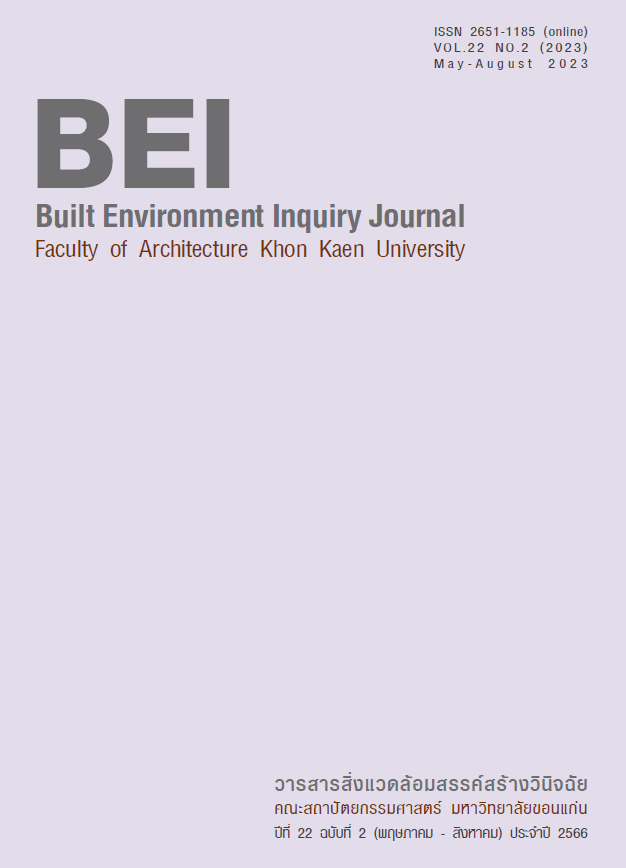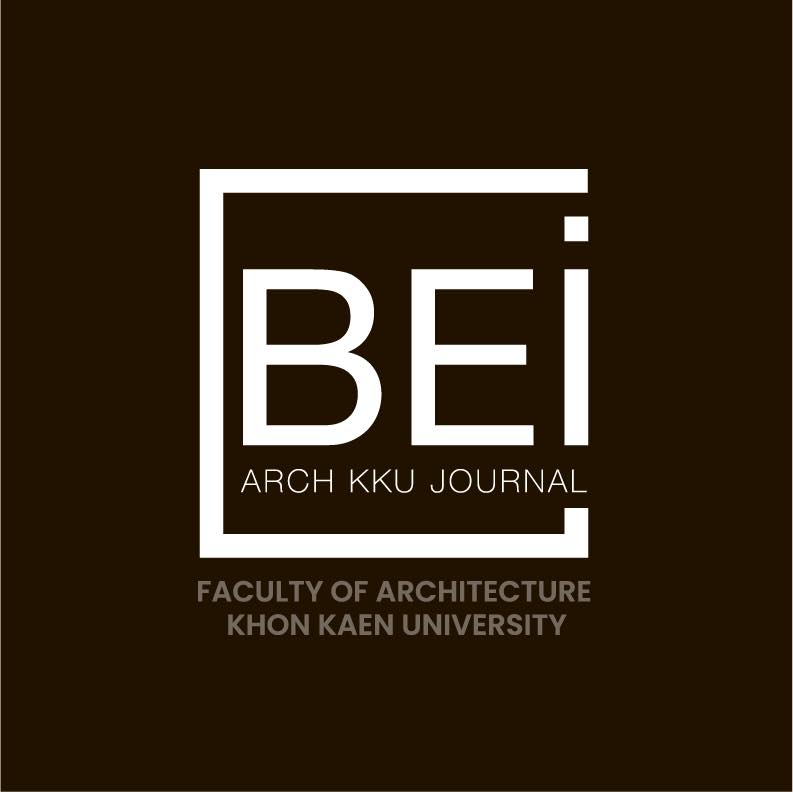ความสัมพันธ์ระหว่างเวลาและสถาปัตยกรรม
DOI:
https://doi.org/10.14456/bei.2023.17คำสำคัญ:
เวลา, เวลาเชิงเส้น, เวลาเชิงวัฏจักร, ความสัมพันธ์ทางสถาปัตยกรรมบทคัดย่อ
บทความนี้มุ่งอภิปรายประเด็นเรื่องความสัมพันธ์ระหว่างเวลากับสถาปัตยกรรม ทั้งเวลาเชิงเส้นและเชิงวัฏจักร เวลามีอิทธิพลทั้งในแง่ของการรับรู้สถาปัตยกรรมและสภาพแวดล้อม การเปลี่ยนแปลงนั้น อาจจะเกิดได้จากทั้งความตั้งใจและไม่ตั้งใจ โดยเวลาเชิงเส้นจะมีความต่อเนื่องที่เกี่ยวข้องกันของอดีต ปัจจุบัน และอนาคต ผู้คนจึงถูกเชื่อมโยงเข้ากับสภาพแวดล้อมผ่านการเปลี่ยนแปลงแบบพลวัติ ซึ่งการเปลี่ยนแปลงนี้เกิดขึ้นทั้งในระดับสังคมและระดับปัจเจกบุคคล ส่วนเวลาเชิงวัฏจักรจะถูกแสดงผ่านกิจกรรมและความหมายที่ซ้ำซาก ซึ่งสัมพันธ์กับสถาปัตยกรรม โดยอาจเกิดซ้ำเป็นรายวัน รายสัปดาห์ รายเดือน รายปี อาจกล่าวได้ว่าสถาปัตยกรรมคือ ร่องรอยของอดีตที่เกิดขึ้นตามการเปลี่ยนแปลงของแต่ละยุคแต่ละสมัยโดยสัมพันธ์กับเวลา สิ่งเหล่านี้สะท้อนความสัมพันธ์แบบพลวัต ไหลลื่น และการเปลี่ยนแปลงระหว่างผู้คน สถาปัตยกรรม และสภาพแวดล้อม โดยผู้เขียนจะอภิปรายและชี้ให้เห็นถึงประเด็นที่ว่า เวลาเชิงเส้นและเวลาเชิงวัฏจักรกับสัมพันธ์สถาปัตยกรรมอย่างไร
References
ต้นข้าว ปาณินท์. (2558). ปรากฎ-กาล ชีวิตของสถาปัตยกรรมผ่านกาลเวลา. กรุงเทพ: สำนักพิมพ์ ลายเส้น
Altman, I., & Gauvain, M. (1981). A cross-cultural and dialectic analysis of homes. In L.Liben, A. Patterson, & N. Newcombe (Eds.). Spatial representation and behaviour across the life span. (pp. 283–319). New York: Academic,
Barnes, J. (Ed). (1984). The Complete Works of Aristotle. Princeton, NJ: Princeton University Press
Bachelard, G. (1964). The poetics of space. New York: Orion Press
Ballantyne, A. (2002). What is Architecture. London and New York: Routledge.
HOON, M. (2017). Moon Hoon: What is architecture? Retrieved from https://youtu.be/PIhFxgwBE5Q
Korosec-Serfaty, P. (1984). The home, from attic to cellar. Journal of Environmental Psychology, 4, 303–321.
Mostafavi, M., & Leatherbarrow, M. (1993). On Weathering: The Life of Building in Time. Cambridge: MIT Press.
Lee, P. (2016). The History of Architecture in a Nutshell. Retrieved from https://www.widewalls.ch/magazine/the-history-of-architecture
Lynch, K. (1972). What time is this place? Cambridge, Mass: M.I.T. Press
Marsh, R. (2017). Building Lifespan and Function. Retrieved from Linkedin: https://www.linkedin.com/pulse/building-lifespan-function-sustainability-yes-really-rob-marsh.
Petonnet, C. (1973). Those people: The subculture of a housing project. Westport, Conn.: Greenwood Press
Rakowski, W. (1979). Future time perspective in later adulthood: Review and research directions. Experimental Aging Research, 5, 44–88
Rapoport, R. (1977). Human aspect of urban form. Oxford: Pergammon Press.
Relph, E. (1976). Place and placelessness. London: Pion
Seamon, D. (1982). The phenomenological contribution to environmental psychology. Journal of Environmental Psychology, 2, 119–140.
Stanford Encyclopedia of Philosophy (1995). Time: Argument that Time is not Real. Retrieved from https://iep.utm.edu/time/.
Stolarewicz, M. (2012). Time as a Designing Factor in Architecture Creation. New Design Concepts and strategies, volume 2, 551–556.
Tanner, A. (1979). Bringing home animals. Religious ideology and mode of production of the Mistassini Cree hunters. New York: St. Martin's Press
Tuan, Y. (1977). Space and place: The perspective of experience. Minneapolis: University of Minnesota Press
Wittman, M. (2019). Psychology Today. Retrieved from https://www.psychologytoday.com/us/blog/sense-time/201908/feeling-time-in-space-how-architecture-is-all-about-time.
Downloads
เผยแพร่แล้ว
How to Cite
ฉบับ
บท
License
Copyright (c) 2023 สิ่งแวดล้อมสรรค์สร้างวินิจฉัย

This work is licensed under a Creative Commons Attribution-NonCommercial-NoDerivatives 4.0 International License.
ทัศนะและข้อคิดเห็นของบทความที่ปรากฏในวารสารฉบับนี้เป็นของผู้เขียนแต่ละท่าน ไม่ถือว่าเป็นทัศนะและความรับผิดชอบของกองบรรณาธิการ



